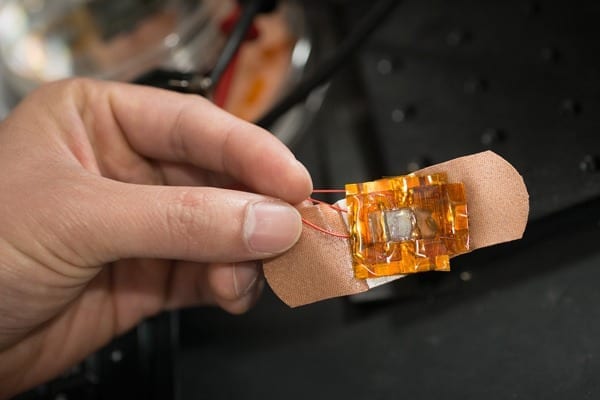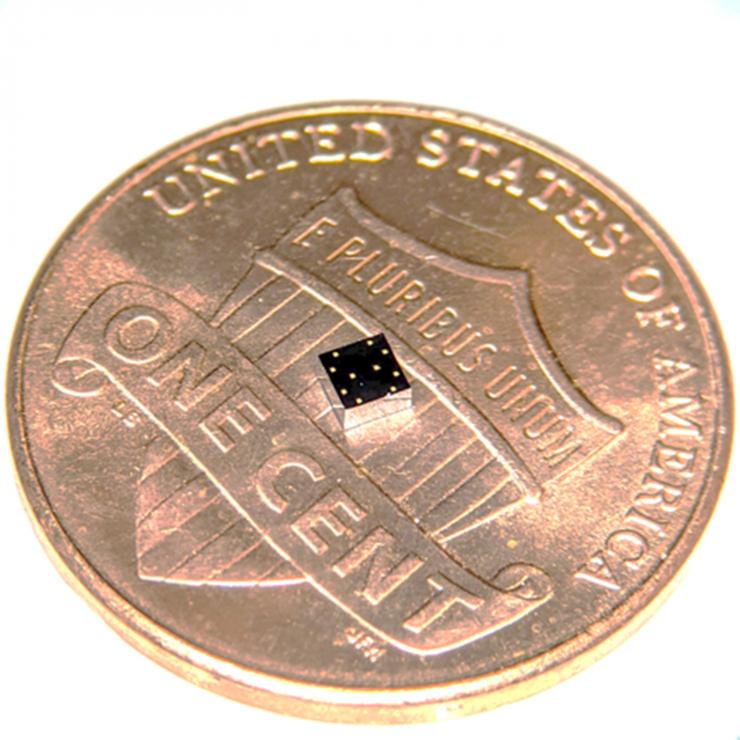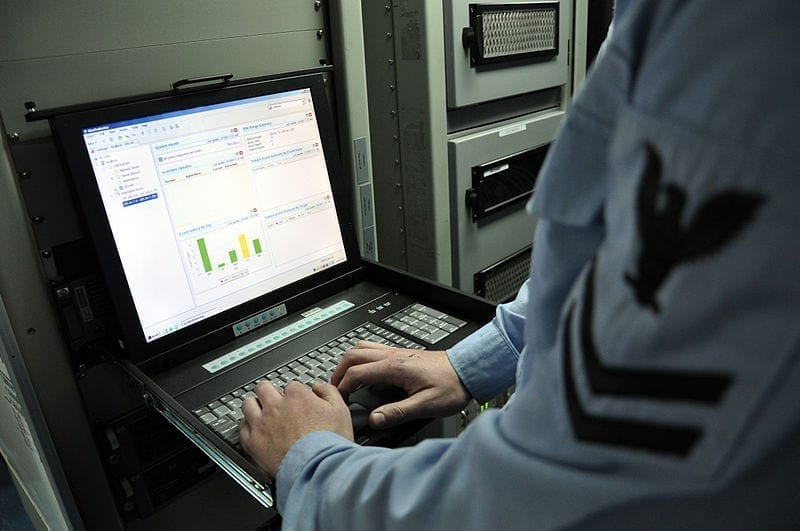
Engineers combine layers of flexible materials into pressure sensors to create a wearable heart monitor thinner than a dollar bill.
The skin-like device could one day provide doctors with a safer way to check the condition of a patient’s heart.
Most of us don’t ponder our pulses outside of the gym. But doctors use the human pulse as a diagnostic tool to monitor heart health.
Zhenan Bao, a professor of chemical engineering at Stanford, has developed a heart monitor thinner than a dollar bill and no wider than a postage stamp. The flexible skin-like monitor, worn under an adhesive bandage on the wrist, is sensitive enough to help doctors detect stiff arteries and cardiovascular problems.
The devices could one day be used to continuously track heart health and provide doctors a safer method of measuring a key vital sign for newborn and other high-risk surgery patients.
“The pulse is related to the condition of the artery and the condition of the heart,” said Bao, whose lab develops artificial skin-like materials. “The better the sensor, the better doctors can catch problems before they develop.”
Your pulse
To find your pulse, press your index and middle finger into the underside of your opposite wrist. You should feel the steady rhythm of your heart as it pumps blood through your veins.
Each beat you feel is actually made up of two distinct peaks, even though you can’t tell them apart with just your fingers. The first, larger peak is from your heart pumping out blood. Shortly after a heartbeat, your lower body sends a reflecting wave back to your artery system, creating a smaller second peak.
The relative sizes of these two peaks can be used by medical experts to measure your heart’s health.
“You can use the ratio of the two peaks to determine the stiffness of the artery, for example,” said Gregor Schwartz, a post-doctoral fellow and a physicist for the project. “If there is a change in the heart’s condition, the wave pattern will change. Fortunately, when I tested this on myself, my heart looked fine.”
To make the heart monitor both sensitive and small, Bao’s team uses a thin middle layer of rubber covered with tiny pyramid bumps. Each mold-made pyramid is only a few microns across – smaller than a human red blood cell.
When pressure is put on the device, the pyramids deform slightly, changing the size of the gap between the two halves of the device. This change in separation causes a measurable change in the electromagnetic field and the current flow in the device.
The more pressure placed on the monitor, the more the pyramids deform and the larger the change in the electromagnetic field. Using many of these sensors on a prosthetic limb could act like an electronic skin, creating an artificial sense of touch.
When the sensor is placed on someone’s wrist using an adhesive bandage, the sensor can measure that person’s pulse wave as it reverberates through the body.
The device is so sensitive that it can detect more than just the two peaks of a pulse wave. When engineers looked at the wave drawn by their device, they noticed small bumps in the tail of the pulse wave invisible to conventional sensors. Bao said she believes these fluctuations could potentially be used for more detailed diagnostics in the future.
The Latest Bing News on:
Monitoring heart health
- Heart health and diabetes: How can diabetic patients tackle cardiac arreston April 28, 2024 at 12:17 am
Risk of cardiac arrest can be daunting concern for diabetics but these proactive steps can significantly mitigate risk and enhance overall cardiovascular health ...
- Don't just track your steps. Here are 4 health metrics to monitor on your smartwatch, according to doctors.on April 26, 2024 at 2:00 am
Are you using your smartwatch to the fullest? Here are 4 metrics doctors say can be useful to track beyond your daily step count.
- Smart infant monitoring company Owlet partners with Wheelon April 25, 2024 at 4:13 pm
“We’re thrilled to announce our strategic partnership with Owlet, a leader in smart infant monitoring. This collaboration marks a significant milestone in our mission to expand healthcare access and ...
- Livestock farmers urged to embrace vaccination to curb diseaseson April 25, 2024 at 8:31 am
Reluctance by some livestock farmers to vaccinate their animals, some diseases which were previously known among animals, have since jumped to humans which may spark more pandemics in communities ...
- Global Cardiac Ambulatory Monitoring Industry expand at a high 5.2% CAGR and reach a startling US$ 21.6 Billion valuation by 2032 | FMIon April 25, 2024 at 6:06 am
The Global Cardiac Ambulatory Monitoring Industry is poised for a promising future, driven by rising concerns about heart health. According to a recent analysis by Future Market Insights (FMI), the ...
- American Heart Association distributes 300 blood pressure kitson April 23, 2024 at 11:00 am
American Heart Association distributes blood pressure kits to under-resourced communities to promote healthy living and prevent heart disease.
- Smartwatch AI predicts atrial fibrillation 30 minutes before it arriveson April 22, 2024 at 9:21 pm
AI trained on simple heart rate data can predict an episode of the most common heart rhythm disorder, atrial fibrillation, 30 minutes in advance, new research has shown. With plans for it to be ...
- Leveling the field: MSU researcher develops new, affordable detection and monitoring methods for cardiovascular diseaseon April 22, 2024 at 9:25 am
A Mississippi State University researcher is developing new, more affordable methods for early detection and monitoring of cardiovascular disease, the leading cause of death in the U.S.
- Transforming Telehealth: How AI-Powered Virtual Consultations and Remote Monitoring Are Shaping the Future of Healthcareon April 22, 2024 at 2:58 am
Discover how AI-powered telehealth is transforming healthcare with advanced virtual consultations and remote monitoring, enhancing accessibility and efficiency. Explore the integration of AI in ...
- Withings smart scales, watches announced in India for addressing heart health issueson April 16, 2024 at 8:20 pm
Withings, a brand well-known for its connected health devices and the inventor of the first connected smart scale, has announced its official availability in India. Its arrival in the country brings ...
The Latest Google Headlines on:
Monitoring heart health
[google_news title=”” keyword=”monitoring heart health” num_posts=”10″ blurb_length=”0″ show_thumb=”left”]
The Latest Bing News on:
Wearable heart monitor
- Hurry! The current-gen Apple Watch 9 just crashed to its lowest price ever at Amazonon April 28, 2024 at 8:13 am
Spring is in the air, and so are plenty of great Apple deals. And if you've been thinking about upgrading your Apple Watch, there's a rare opportunity to save big on one of the best smartwatches we've ...
- Ask the Doctors | New technology helps with diabetes managementon April 28, 2024 at 3:18 am
An insulin pump is also a wearable medical device. It’s about the size of a pack of cards and, either via a tube, needle or patch, delivers subcutaneous insulin.
- Effortless Parenting: The Ultimate Guide to the 10 Best Tech Gadgets for Momson April 26, 2024 at 5:03 am
Parenting is a journey filled with love, joy, and, let’s face it, challenges. From sleepless nights to endless diaper changes, moms have their hands full from the moment their little ones arrive.
- Wearable Medical Devices Market Unveiling Insights Maximizing the Value of Focus Groups in Qualitative Researchon April 25, 2024 at 8:42 pm
Wearable Medical Devices Market is valued approximately USD $ billion in 2019 and is anticipated to grow with a healthy growth rate of more than 5.1% over the forecast period 2020-2027. Wearable ...
- The best smartwatches and fitness trackers for kids can help the whole family stay connectedon April 25, 2024 at 1:09 pm
The XGO 2 strikes the perfect balance of independence for kids and control for parents in an all-in-one mobile watch. You will need to purchase a subscription, but it's the cheapest option available ...
- Wearable-Tracked Walking Behavior Hints at Subclinical HFon April 23, 2024 at 11:13 am
Beyond step count, other measures like cadence and exercise capacity could detect an early signal before symptoms develop.
- AFib May be More Common in People Under 65 Than Previously Thoughton April 23, 2024 at 6:28 am
A new study suggests that atrial fibrillation (AFib) may be more common in people under 65 than shown by previous research ...
- I’ve seen the future, and it’s really salty: Testing Flowbio’s new wearable hydration sensoron April 22, 2024 at 5:31 am
The sold-out sensor already has WorldTour adoption, but given time it could become as ubiquitous as the heart rate monitor ...
- Revolutionizing Fitness: Wearable Fitness Tracker Market Set to Soar, Projected at US$30.9 Billion in 2024on April 18, 2024 at 6:02 am
The global wearable fitness tracker market is anticipated to reach a valuation of US$ 30,922.1 million in 2024, driven by incorporation of AI and ML. The trend is expected to create new opportunities ...
- Truth Behind Wearable Device Accuracyon April 14, 2024 at 3:00 pm
Using the thermal camera to monitor a ... reasonable job at measuring heart rate and adding a thermal camera would provide a means for measuring respiratory rate. No solution exists for measuring CO2 ...
The Latest Google Headlines on:
Wearable heart monitor
[google_news title=”” keyword=”wearable heart monitor” num_posts=”10″ blurb_length=”0″ show_thumb=”left”]











